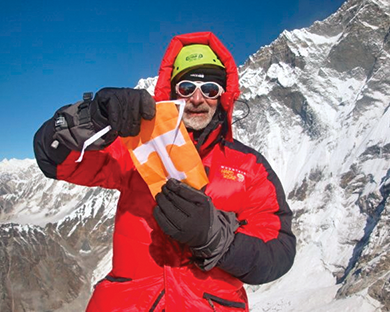An Ongoing Neutron Mystery

Geoff showing off some Volunteer pride on top in Nepal
(Lhotse in the background)
Geoff Greene may have officially retired from the university, but he’s by no means going to abandon the neutrons he’s been following closely for most of his career. Their relationship dates to when he was fresh out of graduate school, but his love for science began much earlier.
"I was always interested in mechanical things and in science," Greene said, "but a huge influence was a book I read in junior high school called One Two Three … Infinity by George Gamow.
"Gamow was a great physicist and gifted popularizer of science," he explained. "One Two Three … Infinity discussed transfinite numbers, relativity, cosmology, quantum mechanics and more in an amazing and accessible way. I was hooked."
Greene took that enthusiasm to Swarthmore College, where he earned a BA in physics and played on the baseball team. He went on to complete both master’s (1974) and doctoral (1977) degrees at Harvard University, where he pulled for the Boston Red Sox, whose triumphs and heartbreaks he’s shared ever since.
After graduate school he worked at the Rutherford Appleton Laboratory in Oxford, England, and the Institut Laue Langevin's high flux reactor in Grenoble, France. This scientific globetrotting set the path for his life’s work.
"During that time I first learned about neutrons, which have been a passion ever since," he said.
Specifically, Greene’s passion is pinning down how long a neutron lives. How a neutron decays is a window into how the sun produces energy and why the Big Bang left us with a balance of elements that supports life as opposed to a vast emptiness.
Greene has followed these questions for decades. After a stop on the Yale University faculty, he went to the National Bureau of Standards (now the National Institute of Standards and Technology) where he focused on the measurement of fundamental constants: descriptions of the particles and forces that make up our universe and how they interact. From there he went to Los Alamos National Laboratory to help set up a fundamental neutron physics program. He served as deputy director for research at the Los Alamos Neutron Science Center (LANSCE), home to one of the country’s most powerful linear accelerators.
Always following—and developing—the best tools, Greene came to UT in 2002 with a joint appointment at Oak Ridge National Laboratory. The national lab is home to the Spallation Neutron Source (SNS), which was then under construction. Greene rolled up his sleeves to build the Fundamental Neutron Physics Beamline. Of all the SNS beamlines, it’s the only one that studies the neutron itself, rather than using it to study other materials.
There are two approaches for measuring neutron decay: beams and bottles. The first, which Greene uses, looks at the rate at which neutrons in flight decay. He has colleagues elsewhere who use bottle-driven experiments, yet the two methods reach different conclusions, with a gap of about 10 seconds. The neutron lifetime is still an unsolved mystery, with plenty more ground to cover.
Greene has spent time at nearly every facility in the world that does this kind of neutron science. He drew on that experience to develop fundamental neutron programs in the US and build facilities that move this research forward. He also served on the Nuclear Science Advisory Committee, which helps federal agencies map out the country’s nuclear physics agenda. In 2021 the American Physical Society awarded him the Tom W. Bonner Prize for Nuclear Physics in recognition of these contributions.
Since arriving at UT two decades ago, Greene has embraced the role of professor. He’s mentored graduate students in nuclear physics, served on the department’s planning committee, and managed to turn quantum mechanics into the most popular undergraduate physics course (the students showed their gratitude with the 2011 Teacher of the Year Award). He’s also quick to give credit to physics faculty and staff who’ve supported his work, especially Associate Professor Nadia Fomin and the entire staff of the department’s machine shop. In 2016 the university awarded him the Alexander Prize for his superior teaching and distinguished scholarship.
A dedicated mountaineer, Greene has carried UT’s colors to summits across the Alps and the Himalaya and hopes to find more time for this and other hobbies in retirement. There will, once COVID recedes, be more skiing, hiking, and spending a good deal of time with his family, now as a new grandfather. He also plans to continue working on the neutron lifetime project with Fomin. The neutrons may be decaying … but they aren’t going anywhere.